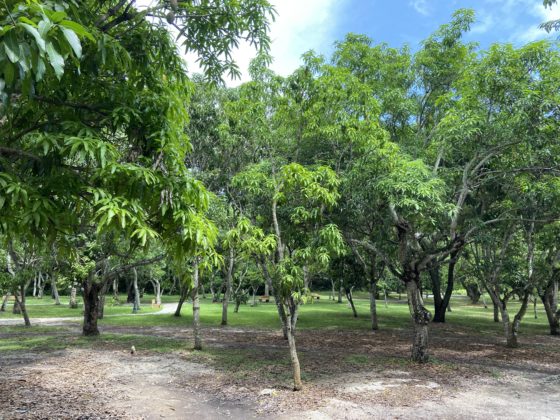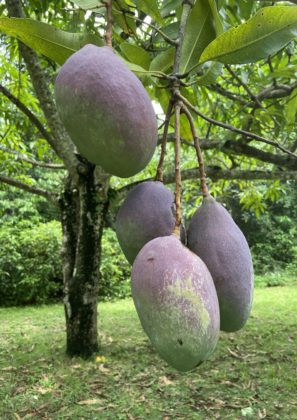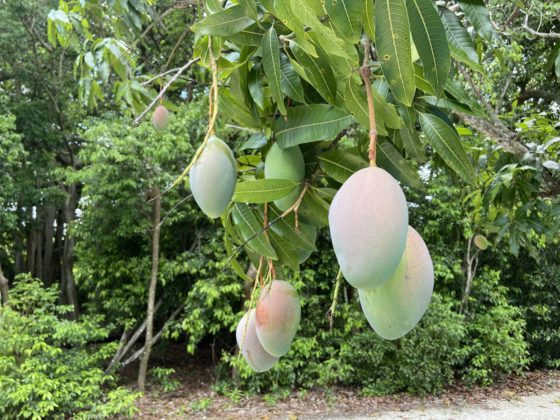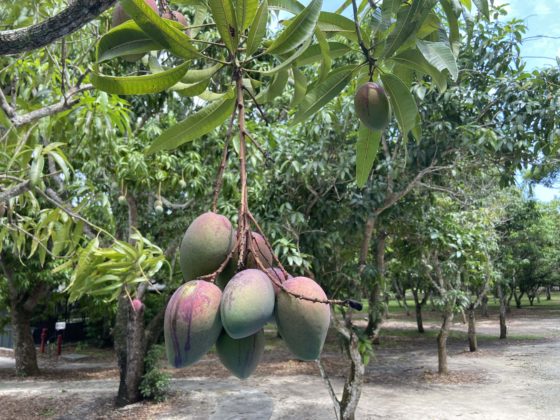|
Getting your Trinity Audio player ready...
|
with contributions by: Tamara McDonald, J.D.
With over 150 mango trees at the Deering Estate, spanning 10 different species, Mangos have become a staple snack for guests and employees over the summer months. Some of the types of mangos that you may find growing at the Deering Estate today include Ambrosia, Kent, Parvin, and Turpentine. The most commonly seen variety are the Haden mangos. Mangos have been grown in the area since the late 1800s. Pioneer settlers like William Fuzzard planted a variety of fruits including bananas, citrus and the delicious mango. As larger communities began to form, people started to cultivate larger groves of trees, finding that they were great for consumption and could be very profitable. The tannins found in the bark were commonly used in leather and other goods.
At Charles Deering’s property Buena Vista, researchers were already hard at work, growing various fruit bearing trees like avocados and mangos. Mangos became a top priority as they worked to determine the best growing conditions, from what light worked best to the types of soil and pest treatments used. By 1922 the Buena Vista groves had 856 mango trees mostly of the Haden species. When Deering’s Estate at Cutler was being constructed, he set out to have seedlings and trees from Buena Vista relocated to Cutler under the guidance of naturalists and researchers like John Kunkel Small, O.C. Simmonds and F.M. Button.
As the years have passed, natural disasters like Hurricane Andrew and Irma, have affected the landscape including the mango grove at the Deering Estate. The Deering Estate Staff continues its stewardship of the estate and the preservation of the natural areas including the Mango grove started by Charles through the replantation of seedlings.
Roselyn Roberts (Rose) a landscape technician for the estate and Tamara McDonald, the museum’s Associate Registrar share insights on aspects of the mango grove with me below:
Q: After natural disasters like Hurricane Irma, other than replanting the seeds, what other steps do you take to restore the mango trees and the environment around them?
A: (Rose) After a hurricane, it is best to trim broken limbs off your mango tree. [You should] also fertilize [in] early spring before new growth and after harvesting.
Q: What conditions at the Estate help mangos grow and prosper?
A: (Rose) Our weather, soil and rain accumulation are perfect for growing mangos at Deering Estate and [in] South Florida.
Q: Why were mangos chosen to be grown at the Deering Estate?
A: (Tamara) Both mangos, oranges and avocados had been growing here for years before in the Pioneer era. From my research it seems that the research aspect of Buena Vista appealed to Charles because the crops cultivated were some of the leaders in the agricultural industry in Florida. The problem was figuring out how to grow them well here on a large scale successfully and combat problems growers were having with growing conditions and pests.
Charles was interested in all things nature. If something posed even a hint of an interesting option he was there, the Deering’s even hosted gardening classes for the community so people could learn how to work with certain trees and plants here to encourage people to work with nature and learn.
- How do you differentiate between the different species of mangos at the Estate?
A: (Rose) There are so many varieties of mangos from all over the world and new varieties constantly being developed. The major varieties can be recognized… [easily] by odor, shape, taste, and degree of fiber inside.
There was a team of 4-5 of us when we ID the ones here at the park. The old trees were … easy [to identify], they were planted by Mr. Deering over a hundred years ago and I’m sure David Fairchild had a hand in planting them. Most are Haden that were grafted onto a peach seedling.
The new trees, by the pavilions, were planted after hurricane Andrew and are an array of different varieties and probably different root stock.
Mangos have kept their popularity at the Estate and are enjoyed by visitors from all over the world. Plan a visit to the Estate and enjoy the summer sun and a few mangos. You can even purchase fresh ones at the Deering Estate main entrance, 3 mangos for only $1!









